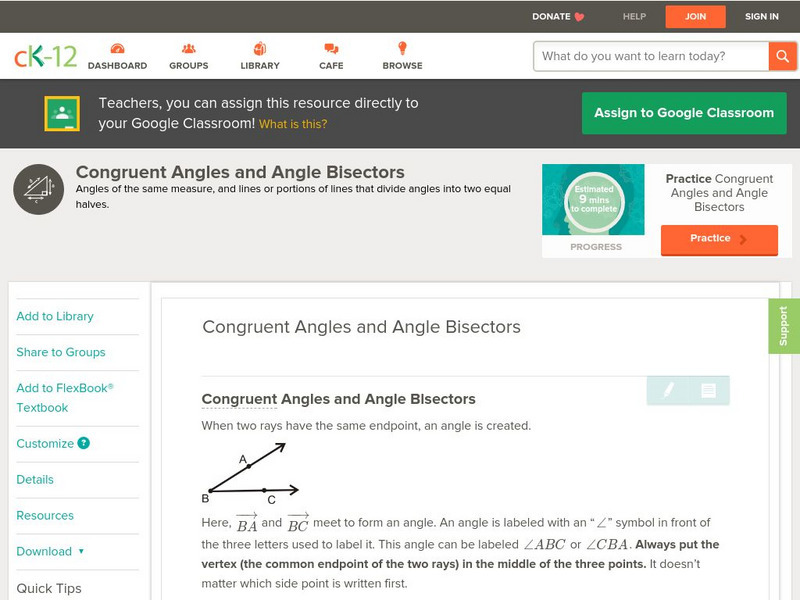Hi, what do you want to do?
Curated OER
Quandaries, Quagmires, and Quadrilaterals
Students classify, flip, slide, and turn a quantity of quadrilaterals.
Curated OER
Introduction to Fractals: Geometric Fractals
Students study and observe the patterns made by the areas of the Sierpinski Triangle. Students use the computer to draw two or three iterations to discover the number patterns. Students complete worksheets based on Geometric Fractals.
Curated OER
Rep Tiles
Third graders use pattern blocks of one shape at a time to try to create a similar shape. They compare the perimeter of the new figure with the perimeter of the original shape and look for a pattern. Students use the pattern to predict...
Curated OER
Talking about your name in math terms
Young scholars talk about mathematical language. In this talking about your name lesson, students use the letters in their own name to review math vocabulary and concepts.
Curated OER
Similar Triangles
Ninth graders find the height of every day objects using techniques learned through postulates that allow triangles in a problem to be similar. They calculate the length of a missing side and solve proportions.
Curated OER
Math Vocabulary Multiple Choice Words Worksheet
In this math vocabulary worksheet, students complete multiple choice problems where they match the correct math vocabulary word to its definition. Students complete 15 questions.
Curated OER
An Introduction to Quadrilaterals
Learners explore different types of quadrilaterals. Students define the terminology used with quadrilaterals. They create particular quadrilaterals based on specific characteristics of the quadrilaterals using an online tool.
Curated OER
Ship Shape
Second graders explore shapes. After reading books about shapes, 2nd graders describe the properties of various shapes. They identify shapes if they have been rotated, flipped, or slid. Students create shapes using drawings and geoboards.
Curated OER
Pythagorean Theorem
Students explore how the Pythagorean Theorem works and how to apply it.
Curated OER
Pythagorean Theorem
Students are introduced to the Pythagorean theorem. They use three different activities that give students the opportuntiy to observe triangles, and use the Pythagorean theorem and practice different ways of determining areas of...
Curated OER
Visual Patterns in Tessellations
Students explore tessellations as well as various types of polygon. Students examine tessellating patterns in the world around them. Students examine tessellations by creating their own tessellations and completing the included worksheet.
Curated OER
Translations, Reflections, and Rotations
Students are introduced to the concepts of translation, reflection, and rotation. They practice translating, reflecting, and rotating two-dimensional objects on the coordinate plane. students use computers to learn about the three concepts.
Curated OER
Fractals
Students explore the concept of fractals. In this fractal lesson, students use applets to explore Koch's Snowflake, Sierpinski's Triangle, and other fractals. Students develop these concepts through exploration and teacher guided...
Curated OER
Math Vocabulary Definitions-Multiple Choice
In this math vocabulary activity, students complete 15 multiple choice problems, choosing the correct definition for a set of math terms. A reference web site is included for additional activities.
Curated OER
Exploring Arrangements of 2, 3, 4, and 5 Cubes
Students use problem solving skills to create various models of tricubes, tetracubes, and pentacubes. They classify the cubes into various groupings and identify them as mirror images, regular arrangements, and irregular arrangements....
Curated OER
Introduction to Fractals: Infinity, Self-Similarity and Recursion
Students think about several of the concepts from fractals, including recursion and self similarity. They use mathematical concepts of line segments, perimeter, area and infinity are used, and skill at pattern recognition is practiced.
Curated OER
Polygons All Around Us!
Students explore the concept of polygon properties. In this polygon properties lesson, students draw polygons with different numbers of sides such as pentagons, octagons, hexagons, etc. Students identify different geometric shapes in the...
Curated OER
Pass It On
Fifth graders participate in a class activity that helps them learn some geometric terms along with their definitions. They describe relationships between two and three-dimensional shapes and analyze attributes and properties of...
Curated OER
Exploring Arrangements of 2, 3, 4, and 5 Cubes
Pupils construct models of various tricubes, tetracubes, and pentacubes that are possible, classify n-cubes into different groupings, and draw these figures on isometric dot paper giving true perspective to what they visualize.
Curated OER
Tangrams
Young scholars construct the tangram pieces from a square paper by following directions to fold and cut. They make observations on the pieces formed and compare how they are related to each other. They explore patterns and shapes with...
CK-12 Foundation
Ck 12: Geometry: Congruent Angles and Angle Bisectors
[Free Registration/Login may be required to access all resource tools.] This concept introduces students to angles, congruent angles, and angle bisectors. Students examine guided notes, review guided practice, watch instructional videos...
CK-12 Foundation
Ck 12: Geometry: Congruent Angles and Angle Bisectors
[Free Registration/Login may be required to access all resource tools.] In this lesson students apply the definitions of angle congruency and angle bisector. Students examine guided notes, review guided practice, watch instructional...
CK-12 Foundation
Ck 12: Congruent Angles and Angle Bisectors
[Free Registration/Login Required] Students explore the concept of congruent angles and angle bisectors by navigating through the interactive learning module and then answering questions that go along with the module. Students can also...




























